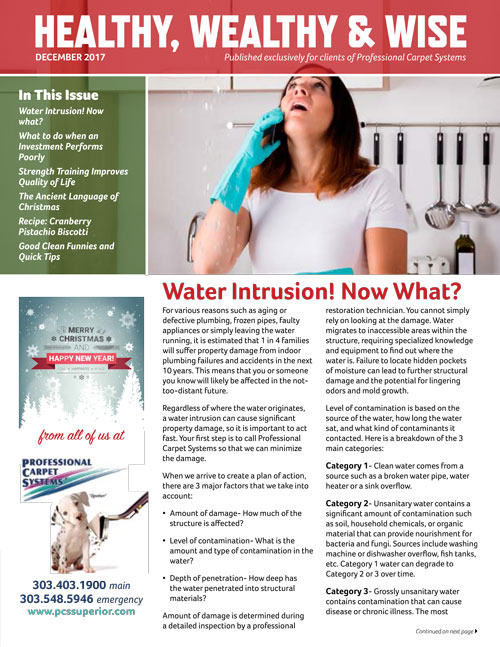Here’s our December 2017 Client Newsletter.
 Click Here to See the Newsletter
Click Here to See the Newsletter
Water Intrusion! Now What?
For various reasons such as aging or defective plumbing, frozen pipes, faulty appliances or simply leaving the water running, it is estimated that 1 in 4 families will suffer property damage from indoor plumbing failures and accidents in the next 10 years. This means that you or someone you know will likely be affected in the not-too-distant future.
Regardless of where the water originates, a water intrusion can cause significant property damage, so it is important to act fast. Your first step is to call Professional Carpet Systems so that we can minimize the damage.
When we arrive to create a plan of action, there are 3 major factors that we take into account:
• Amount of damage- How much of the structure is affected?
• Level of contamination- What is the amount and type of contamination in the water?
• Depth of penetration- How deep has the water penetrated into structural materials?
Amount of damage is determined during a detailed inspection by a professional restoration technician. You cannot simply rely on looking at the damage. Water migrates to inaccessible areas within the structure, requiring specialized knowledge and equipment to find out where the water is. Failure to locate hidden pockets of moisture can lead to further structural damage and the potential for lingering odors and mold growth.
Level of contamination is based on the source of the water, how long the water sat, and what kind of contaminants it contacted. Here is a breakdown of the 3 main categories:
Category 1- Clean water comes from a source such as a broken water pipe, water heater or a sink overflow.
Category 2- Unsanitary water contains a significant amount of contamination such as soil, household chemicals, or organic material that can provide nourishment for bacteria and fungi. Sources include washing machine or dishwasher overflow, fish tanks, etc. Category 1 water can degrade to Category 2 or 3 over time.
Category 3- Grossly unsanitary water contains contamination that can cause disease or chronic illness. The most common source of Category 3 water is backflow from sewer or septic systems. Any water that passes over the ground falls into this category due to fungi, bacteria, animal waste, pesticides, fertilizers and other potential contaminants.
Depth of penetration depends on the permeance of affected materials and the length of time the water remained in contact with those materials. Permeance is the ability of water to absorb into or pass through a material. Drywall is highly permeable, absorbing water easily, while hardwood floors are low-permeance or minimally absorbent. The permeance factor, exposure time and level of contamination in the water determines what materials we can save.
For example, if drywall is saturated for a short time with clean water, it can usually be saved. However, if drywall is saturated with water from a sewage backflow, it should be removed and replaced.
There are different requirements for various materials and levels of contamination. If you consider all of the materials in your home, hardwoods, plywood, drywall, insulation, carpet, structural wood, vinyl, particle board, tile, concrete as well as your furnishings, it’s easy to see why Professional Carpet Systems should be your first call if you should ever have a water intrusion in your home.
We are experts at assessing the damage and tailoring a restoration program to your unique situation.
Our technicians are trained and certified to minimize the damage and protect the health and safety of your family. We’ll act quickly and efficiently to get your home or business dry and clean, so you can get back to normal quickly.
